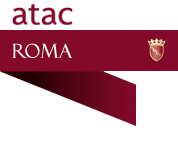ATAC SpA
Azienda per i Trasporti Autoferrotranviari del Comune di Roma (ATAC; Transport Company of the Municipality of Rome) is the company that runs most of the public transportation network in Rome and its surrounding municipalities. Four million trips daily are made using ATAC services, transporting 1,148,966,529 passengers in 2009.[1]
 | |
| Abbreviation | ATAC |
|---|---|
| Formation | 1909 |
| Purpose | Public Transportation |
| Headquarters | Rome |
| Location |
|
Region served | Rome |
CEO | Marco Rettighieri |
President | Francesco Carbonetti |
Parent organization | Comune di Roma |
| Affiliations | UITP |
| Website | www.atac.roma.it |
Formerly called | AATM, ATM |
.jpg)
Public transport in Rome before 1909
The first form of public transportation in Rome, which opened in 1845, was horse-drawn omnibus from Montanara to St. Paul.
When Italy was united, there was a growing demand for public transportation services, so many private companies were created, all doing different, unrelated things. In 1876, an agreement was made between the City of Rome and the Roman Omnibus Society to create more horse-drawn buggies.
In those same years, streetcars began to develop. The first line was from piazza del Popolo to Milvian Bridge. In the next few years, many other streetcars began to develop, and by 1895, there were five lines.
In 1900, the SRTO opened 10 Omnibus lines, four animal-drawn trams and 11 electric trams.
History
Established in 1909 as AATM (Autonomous Municipal Tramway), led by Ernesto Nathan, the company changed its name almost immediately to ATM (Municipal Tramways Company) and inaugurated the Commercial Service on March 21, 1911, with the line III Piazza Colonna - Holy Cross in Jerusalem (ATM lines are numbered with Roman numerals to distinguish them from SRTO lines, which then ran most of the urban tram network).
In 1919, ATM began to gradually absorb SRTO's lines and rolling stock, becoming the dominant transit company in Rome.
In 1926, the Governorate of Rome, which replaced the City, was established. Consequently, ATM changed its name to ATG, and two years later, with the establishment of the first bus lines, the ATG became ATAG (Bus and Tramways Company of the governorate).
On December 21, 1929, the SRTO closed down as it only ran a single line. All of its fleet was trasnfered to the ATAG, which implemented a radical reform of the network by removing all the tram lines within the city center and replacing them with buses from 1 January 1930. After the reform the network was structured on a series of radial lines which originated from a circular internal loop and were interconnected by a circular outer loop.
On 8 January 1937, the first two trolleybuses, 137 and 138, came into service in the Flaminio district.
On August 9, 1944, the city returned to its original status, so the ATAG became ATAC. It started to tackle the difficult task of rebuilding the network and the fleet. For the first two years of the post-war period a minimum service was provided by “trucks," and then in February 1947, ATAC restored the first 6 lines. The return to the pre-war network was not achieved until 1948.
In the 1950s, the highway network in Italy expanded, which caused train ridership to decrease.
In July 1972, the last trolleybus line (47) was closed.
In 2000, ATAC underwent further transformation: it has only retained ownership of the facilities, tram and trolleybus and deposits, while selling the task of managing the business to external concessionaires. The management of most of the lines of Rome is assigned to the Tramway, which is wholly owned by the City of Rome. Some private companies have won the public tender for the management of other local lines, mostly peripheral ones.
References
- ATAC S.p.A. | Azienda per la mobilità